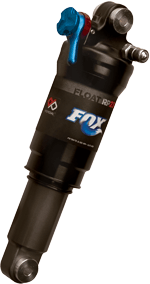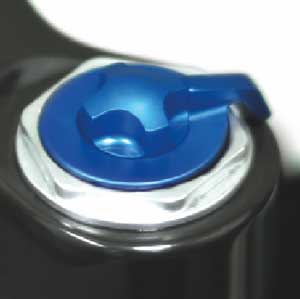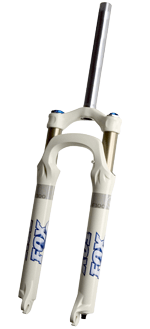FOX Racing Shox : 2007 32mm forks and RP23 shocks

Here are the major updates in FOX’s 32 F-Series, 32 FLOAT, 32 TALAS and 32 VANILLA forks, as well as its new RP23 shocks.
– All forks get stronger and stiffer — and some get more travel — at the same weight.
– ProTune pedal-platform adjustment in F-Series forks.
– Simpler TALAS travel adjustment.
– Better ProPedal adjustment in rear shocks
|
Know your FOX forks
“32” stands for the stanchion diameter. 32 forks are designed for trail riding and light dirt jumping/slalom/4X/urban. 32 F-Series – FOX’s lightest forks. Air springs with open bath cartridge (RLC and RL models) or ProTune pedal platform cartidge (X models). 32 TALAS – Linear air spring with adjustable travel. 32 FLOAT – Air spring. A bit lighter and plusher than TALAS. 32 VANILLA – Coil spring. A tad heavier than air forks, but the plushest. |
Stronger, stiffer fork chassis
FOX engineers learned a lot when they developed their 36 freeride and 40 downhill forks. How massive braking forces twist forks, how big hits affect castings and, of course, how to wring maximum strength from minimum mass. The new 32-mm lowers look a lot like the 36 lowers, only with quick-release dropouts.
The new lower casting (the fork legs and arch) is about twice as strong as before. It handles braking and cornering forces much better, and it’s built to handle more aggressive jumps, drops and other fun stuff. As riders step it up, so does FOX.
FOX engineers said strong brakes tend to make axles walk out of standard vertical dropouts (wheels aren’t falling out, but they are shifting a bit). To counteract this tendency, the new dropouts face forward. This way, the torsional forces help hold the axle in place.
The new crown is thicker and has much more overlap with the stanchions. This increases fore-aft stiffness — the fork is less likely to bend and change your geometry over bumps and under braking — and it reduces creaking.
The FLOAT, TALAS and VANILLA all get bumped up from 130mm to 140mm of travel. Axle-to-crown height is 10mm higher.

|
Easier TALAS travel adjustment
The original TALAS gave riders two inches of adjustment at 3 mm per click — that’s a lot of clicks. FOX found most people rode their TALAS forks all the way up or all the way down, with some riders setting their forks somewhere in the middle, but no one was thinking “12 clicks in for this climb, six clicks in for this singletrack” and writing the numbers on their stems.
So FOX simplified the travel adjustment. Instead of the click-wheel of fortune, TALAS II uses a little blue lever. In 90 degrees of sweep you get three distinct settings: 100mm, 120mm and 140mm. FOX hopes that’ll speed the transitions between climbing and ripping.
The new TALAS is also plusher, thanks to premium seals and a nicely finished steel shaft (which has less friction than the old aluminum one). Compared with the VANILLA, last year’s TALAS had about 20 percent more mechanical friction. The new TALAS has about 12 percent. That’s a two-thirds reduction. Braaap!
All that plus: The new, exposed air valve cap is much easier to open. Go ahead and get that manicure — your fingernails are now safe.

|
ProTune pedaling platform
FOX’s Terralogic platform uses an inertia valve to eliminate bob yet respond to bumps. On smooth ground, the oil ports are closed, and the fork is firm. When you hit a bump, a mass moves, the valve opens and the fork becomes plush.
With the original Terralogic forks, the inertia valve responded well to bumps, but how long that valve stayed open could be a mystery. On smooth ground it might take 10 seconds to close; on rough ground the undamped mass would bounce around and give you alternating lockout and plushness. Will my bike pre-load for this bunny hop? Let’s see …
The new Terralogic valving behaves more predictably. The Brass Mass® inertia valve is damped so it stays open in rough terrain. When the trail smooths out, the valve closes within about a second. So you can hammer with impunity.
Terralogic damping is not a complete lockout — it allows some bleed, so your bike sags and you can pre-load and pump turns as normal. A new ProTune adjustment lets riders adjust between a very stiff RaceTune setting or a softer TrailTune setting. RaceTune uses a high valve threshold to deliver maximum efficiency; TrailTune uses a lower valve threshold to give you more plushness, but still an efficient ride.
ProTune damping comes on the F80 X, F100 X, Float X and TALAS X.
RP23 ProPedal Adjustment

|
The old RP3 rear shock let riders choose between light, medium and heavy ProPedal settings, but few people used the middle setting; they wanted their shock to be either firm or plush. The new RP23 shock gives riders this on-off control plus the ability to set their favorite ProPedal level. A blue lever switches from light to firm ProPedal, and a wheel on the lever determines how firm firm is.
Setting 1: 40 pounds of ProPedal resistance (at the shock), for light riders and an active ride
Setting 2: 100 pounds of ProPedal, for medium riders and a medium ride
Setting 3: 140 pounds of ProPedal, for heavy riders and an efficient ride
FOX expects riders to use the wheel only once in a while to match the terrain or their riding style, but to use the lever throughout rides. Set the lever to firm for pedaling, then switch it to light for descending.
With the RP3, increasing your ProPedal increased all of your damping, so a firm platform meant compromised bump performance. In the RP23, ProPedal is independent of overall compression damping. So you can enjoy an efficient ride that still sucks up the bumps.
In other news: FOX says their new, more precise eyelet bushings should last twice as long as the old ones.

Comments are closed.